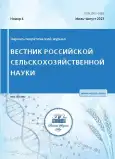Apple trees varieties of VNIISPK selection in production
- Authors: Korneeva S.A1, Sedov E.N1, Yanchuk T.V1
-
Affiliations:
- Russian Research Institute of Fruit Crop Breeding
- Issue: No 4 (2023)
- Pages: 50-54
- Section: Articles
- URL: https://journals.rcsi.science/2500-2082/article/view/141508
- DOI: https://doi.org/10.31857/2500-2082/2023/4/50-54
- EDN: https://elibrary.ru/DLLKZP
- ID: 141508
Cite item
Full Text
Abstract
Keywords
About the authors
S. A Korneeva
Russian Research Institute of Fruit Crop Breeding
Email: info@vniispk.ru
E. N Sedov
Russian Research Institute of Fruit Crop Breeding
T. V Yanchuk
Russian Research Institute of Fruit Crop Breeding
References
- Жданов В.В., Седов Е.Н. Селекция яблони на устойчивость к парше. Тула: Приокское кн. изд, 1991. 208 с
- Кашин В.И. Научные основы адаптивного садоводства. М.:Колос, 1995. 335 с.
- Кичина В.В. Природа сорта и биологические пределы его улучшения // Плодоводство и ягодоводство России: сб. науч. тр. М., 2005. Т.ХII. С. 65-81.
- Красова Н.Г., Галашева А.М., Королев Е.Ю. Результаты изучения сортов яблони селекции ВНИИСПК // Современное садоводство. 2018. № 1 (25). С. 10-17. https://doi.org/10.24411/2312-6701-2018-10102.
- Пикунова А.В., Седов Е.Н. Скрининг сортов и селекционных форм яблони селекции ВНИИСПК на присутствие гена Vf с помощью ДНК-маркирования // Плоды и овощи - основа структуры здорового питания человека: мат. Межд. науч.-практ. конф. Мичуринск-наукоград РФ, 2012. 424 с.
- Программа и методика селекции плодовых, ягодных и орехоплодных культур / Под ред. Е.Н. Седова. Орел: ВНИИСПК, 1995.
- Программа и методика сортоизучения плодовых, ягодных и орехоплодных культур / Под ред. Е.Н. Седова, Т.П. Огольцовой. Орел: ВНИИСПК, 1999.
- Савельев Н.И. Генетические основы селекции яблони. Мичуринск, 1998. 204 с.
- Савельев Н.И., Юшков А.Н., Акимов М.Ю. и др. Устойчивость сортов плодовых культур к абиотическим факторам // Проблемы экологизации современного садоводства и пути их решения: матер. Междунар. конф. Краснодар: Куб ГАУ, 2004. С.40-46.
- Савельева Н.Н., Савельев Н.И. Устойчивость перспективных коммерческих сортов яблони зарубежной селекции к низким температурам // Плодоводство и ягодоводство России: сб. науч. тр. ВСТИСП. М., 2013. Т. ХХХVII.Ч.1. С. 103-120.
- Седов Е.Н., Седышева Г.А., Серова З.М., Янчук Т.В. Интервалентные скрещивания - основной путь создания триплоидных сортов яблони // Российская сельскохозяйственная наука. 2018. № 3. С. 6-10.
- Седов Е.Н., Корнеева С.А., Янчук Т.В., Галашева А.М. Краткие итоги 70-летней (1952-2022 гг.) интенсивной и целенаправленной работы по селекции яблони (популяризация селекционных достижений). Орел: ВНИИСПК, 2022. 36 с.
- Седов Е.Н., Корнеева С.А., Янчук Т.В. Роль отечественной селекции в совершенствовании сортимента яблони в России // Вестник российской сельскохозяйственной науки. 2021. № 4. С. 17-19. doi: 10.30850/vrsn/2021/4/17-19
- Седов Е.Н., Янчук Т.В., Корнеева С.А., Макаркина М.А. Создание российских адаптивных сортов яблони (Malus × domestica Borkh.) ВНИИСПК - смена задач и развитие методов селекции (обзор) // Сельскохозяйственная биология. 2022. Т. 57. № 5. С. 897-910. doi: 10.15389/agrobiology.2022.5.897rus.
- Ульяновская Е.Н., Супрун И.В., Седов Е.Н. и др. Создание иммунных к парше сортов и форм яблони с использованием молекулярно-генетических методов // Вестник РАСХН. 2012. №3. С. 42-44.
Supplementary files










